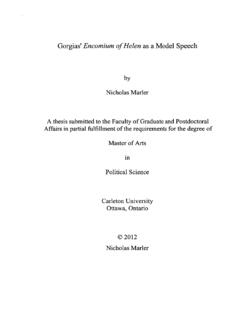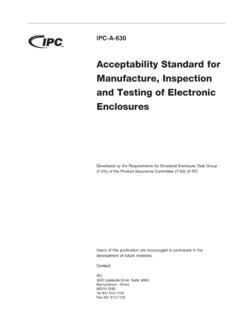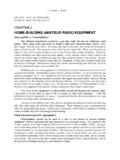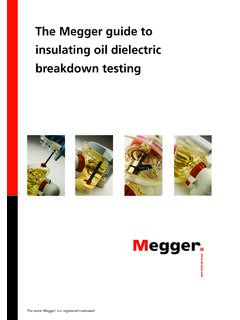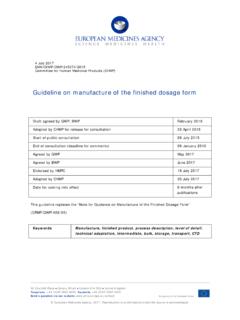Transcription of A Process for the Design and Manufacture of Propellers for ...
1 A Process for the Design and Manufacture of Propellers for Small Unmanned Aerial Vehicles by Brian David Rutkay A thesis submitted to the Faculty of Graduate and Postdoctoral Affairs in partial fulfillment of the requirements for the degree of Master of Applied Science in Aerospace Engineering Carleton University Ottawa, Ontario 2014, Brian David Rutkay ii Abstract The objective of this research was to develop a Process for the Design and Manufacture of mission- and aircraft-specific Propellers for small unmanned aerial vehicles. This objective was met by creating a computer program to Design a propeller that meets user-defined aircraft performance requirements within the limitations of the motor, material, and manufacturing methods.
2 The use of additive manufacturing (3D printing) in making flightworthy Propellers was explored through material testing and by manufacturing trials. By testing the Propellers in simulated flight conditions, it was found that the Propellers generated nearly the expected Design thrust, but a series of manufacturing and instrumentation issues prevented a complete evaluation of their performance. testing was sufficient to demonstrate the feasibility of flightworthy Propellers produced through additive manufacturing. Future work for the further development of the Design program was also outlined. iii Acknowledgements This work was completed over the course of three years but probably would have taken twice as long had it not been for the help of many individuals.
3 I d like to thank the department of Mechanical and Aerospace Engineering lab staff Steve Truttmann, Stephan Bilijan and David Raude for their assistance during material and wind tunnel testing . I d also like to thank Nagui Mikhail for his advice and for allowing me access to the Department of Electronics resources throughout the development of the instrumentation. Throughout my undergrad and graduate studies I ve been grateful for Alex Proctor, Kevin Sangster and Ian Lloy for allowing me to work in the department machine shop and patiently helping me produce what I ve designed. My experiences in the machine shop influenced everything I designed for my thesis and am grateful for the opportunities I had to learn from you.
4 I d like to thank all of my friends for their support throughout the course of this project. There are a few people I d like to recognize in particular for their help on key aspects of this work. Hristo Valtchanov s advice on layout of my thesis led to a drastically better final product than I could have hoped for had I done it my way. I d like to thank John Polansky for his advice and support but in particular helping me polish my defense presentation and selecting the appropriate firearms and ammunition for the ballistic pendulum test. I m grateful for Ryan Anderson for showing me some of the sheet metal fabrication practices he learned while working in the aviation industry and for the great discussions on aircraft and mechanical Design we had, especially back in undergrad when I was starting to develop my mechanical Design skills.
5 I d like to thank Jonathan Wiebe for his help on manufacturing the test rig - luckily for me even after he d iv spent a full day work on his own research work he was willing to help me assemble and troubleshoot problems with the test rig - and for his advice while I was writing the Design program. I also need to thank Aaron Parton for the numerous shawarma-and-beer discussions during development and for Jarome which was used during the ballistic pendulum tests. I definitely need to thank my mom, dad and brother for putting up with me while I was working on my thesis, for the late-night rides home, and for helping me edit and format my thesis. I owe a huge amount of thanks to my dad for spending long days with me in the wind tunnel rather than the golf course over his summer vacation.
6 As rough as testing went, I really enjoyed the opportunity to work with you in the lab and I think it s safe to say it d have been even more hellish and possibly never completed - had it not been for your help. Most of all, I m incredibly grateful for the unwavering and seemingly limitless patience, encouragement and support of my supervisor, Dr. Jeremy Lalibert . This project took much longer than planned and grew significantly in scope, and few would have been able to maintain your high level of enthusiasm throughout the course of the project despite all of the difficulties I encountered. Between getting me into the master s program to spending late nights looking over my thesis, thank you so very much for the amazing opportunities and help you ve provided over the last few years.
7 V Table of Contents Abstract .. ii Acknowledgements .. iii Table of Contents .. v List of Tables .. xiii List of Appendices .. xvii Nomenclature .. xviii 1 Chapter: Introduction .. 22 Motivation .. 22 Objectives .. 22 Methods .. 22 Scope .. 24 2 Chapter: Literature Review .. 25 Overview .. 25 Small Unmanned Aerial Vehicles .. 25 Propeller Design .. 28 Propeller Operation .. 28 Design Methods .. 33 Early Propeller Design Approaches .. 33 Traditional Methods of Design .. 35 UAV Propeller Design .. 38 Airfoils for Propellers .. 40 Propeller Airfoil Series .. 40 Airfoil Data .. 43 Design and testing Requirements for UAV Propellers .. 48 vi Certification Requirements.
8 48 Federal Aviation Regulations - Part 35 (FAR 35) .. 52 ASTM F2506 Standard Specification for Design and testing of Light Sport Aircraft Propellers .. 56 Other Design Requirements .. 59 Materials and Manufacturing .. 62 Overview of Materials for Propellers .. 62 Wood .. 62 Metal .. 64 Composites and Plastics .. 64 Reinforced Plastics .. 66 Additive Manufacturing .. 66 Overview of Additive Manufacturing .. 66 Additive Manufacturing of Aerospace Components .. 68 3 Chapter: Development of the Propeller Design Program .. 71 Introduction .. 71 Design Constraints .. 72 Propeller Size and Speed Constraints .. 73 Aircraft Performance .. 73 Powerplant Characteristics.
9 75 Airfoil Family .. 75 Lift Coefficient Conditions .. 76 Manufacturing Method and Material Properties .. 77 Methods of Blade Design .. 78 Initial Propeller Sizing .. 78 Single-Point Performance Method .. 79 vii Scoring Process .. 85 Detailed Propeller Blade Design .. 87 Optimum Blade Loading Conditions .. 87 Thrust Coefficient and Power Coefficient Modes .. 91 Blade Design .. 92 Simplified Blade Structural 94 Sweep at Speed .. 99 Trailing Edge Correction .. 100 Selecting an Airfoil for a Blade Station .. 103 Propeller Blade Selection .. 104 Detailed Structural Analysis of Propeller Blades .. 105 Aerodynamic Loads .. 105 Mass Loads .. 107 4 Chapter: Material testing .
10 111 Introduction .. 111 The Need for Material testing .. 111 Tensile Stress Rupture .. 112 Objectives of Material testing .. 113 Material testing .. 114 Overview .. 114 Materials Tested .. 115 Guidance for testing .. 116 Test Specimen Design .. 116 Tensile testing .. 117 Overview .. 117 Test Equipment & Procedures .. 117 viii Round 1 Tensile testing .. 118 Summary .. 118 Lessons Learned From Round 1 testing .. 122 Round 2 Tensile testing .. 123 Summary of testing .. 123 Lessons Learned From Round 2 129 Stress Rupture testing .. 131 Overview .. 131 Initial testing .. 131 Stress Rupture Test Rig .. 131 Stress Rupture testing .. 133 Effect of Tensile Stress on 134 Conclusions.
